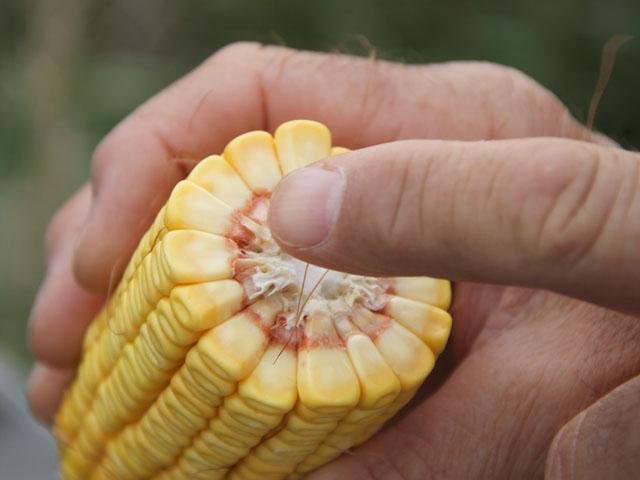Will Late-Planted Corn Beat the Freeze?
Estimating Corn Dry Down Offers Insight as to When Combines Can Roll
JEFFERSON CITY, Mo. (DTN) -- Portions of the upper Midwest experienced the first frost of the fall season Wednesday morning, and cooler temperatures this week have many growers questioning if their late-planted corn will be ready to combine before the first freeze. Understanding how weather influences grain moisture and corn dry down can help forecast harvest timing.
"Estimating dry down is definitely more of an art versus a science," said Dana Harder, a certified crop adviser and field agronomist with Burrus Seed who covers Missouri and west-central Illinois. "The easiest place to start is looking at that milk line to predict where your moisture is."
The milk line is a visible boundary on a corn kernel marking where the liquid and starch are divided. It can be detected on the back side of the kernel opposite the embryo between early dent (R5) and black layer (R6) stages.
At the R5 stage, estimated grain moisture is still about 50%-55% in the kernel. As more of the kernel is converted to starch, the milk line recedes, and the grain moisture decreases.
"By the time the milk line is about halfway down the kernel, you're at 40%-45% moisture and susceptible to 12%-15% yield loss due to freeze," Harder told DTN. "That potential loss drops to 5%-6% when the milk line is three-quarters of the way down from the kernel cap. At black layer, the kernel is still at 30%-35%, but a freeze no longer poses a risk to yield."
Once black layer is achieved, Harder said the best way to estimate dry down for harvest is looking at growing degree days (GDDs). For every four GDDs a corn crop receives per day, it will dry 0.1 point of moisture, he said.
Each additional day in a corn hybrid's relative maturity equates to about 0.5 point of moisture when compared to other hybrids. So, a 113-day corn hybrid planted at the same time as a 110-day hybrid would have 1.5 more points of moisture if they were harvested the same day.
"As a good rule of thumb, through late September and early October, corn will receive enough GDDs to dry down 0.6 points of moisture per day," Harder said. "As we progress in the fall, temperatures cool and we're not racking up those heat units. So, dry down decreases to 0.4 points per day by the latter half of October and down to 0.2 points per day in November."
P[L1] D[0x0] M[300x250] OOP[F] ADUNIT[] T[]
Harder added the Midwestern Regional Climate Center provides an online tool growers in the Corn Belt can use to estimate corn maturity by historic 30-year average GDDs in their area.
DTN Ag Meteorologist John Baranick said while no freeze is yet expected, portions of eastern Iowa, northern Illinois, Wisconsin and Michigan were forecast to experience frost again Thursday morning.
"Temperatures will be warming up after that, and I don't see a good chance for cooler temperatures until maybe late next week," Baranick said. "Models are trying to figure out if the Corn Belt will get the cold shot or if it will stay in eastern Canada and the Northeast. Still, it would likely be on the order of a couple of hours below freezing, and not a widespread hard freeze."
He added temperatures are looking likely to stay above normal during most of October, so the risk of a hard freeze is quite low.
While weather does play the largest role in corn dry down, physical characteristics of individual hybrids also factor into the equation.
"The corn husk is a big one. If it's really wrapped tight around the ear, you're going to hold more moisture," Harder said. "The number of leaves in the husk, its thickness and how much of the ear is covered also impacts dry down."
Corn ears that droop instead of remaining upright tend to dry faster, as they don't retain as much moisture after a rain, Harder said. Hybrids with narrower cobs also tend to dry slower, as do those with "flintier" kernels.
In its weekly Crop Progress report released Monday, USDA NASS estimated 58% of the corn crop had reached maturity, which was 3 percentage points behind the five-year average. As of Sept. 25, 12% of corn had been harvested.
Harder said while the calendar might show that corn planted on June 1 is 31 days behind corn planted on May 1, that disparity narrows when comparing by accumulated GDDs.
"Even though we're 30 days different on the calendar, if we go by the historical heat units, it's really only an 18- to 23-day difference," he said. "We were actually behind the historical averages for the first two weeks of May, but then we got warm enough that we made up some of that difference throughout the growing season."
He added many areas also experienced above-average temperatures in September, which should help late-planted corn receive more GDDs and hasten dry down.
"The best way to estimate your late-planted corn maturity is to go out and take some grain samples," Harder said. "See where that milk line has progressed and see if you've reached black layer."
Access the online corn dry down tool at: https://mrcc.purdue.edu/….
More information on estimating corn dry down from Burrus Seed: https://burrusseed.com/….
Also see estimating corn yield: https://www.dtnpf.com/….
Jason Jenkins can be reached at jason.jenkins@dtn.com
Follow him on Twitter @JasonJenkinsDTN
(c) Copyright 2022 DTN, LLC. All rights reserved.






